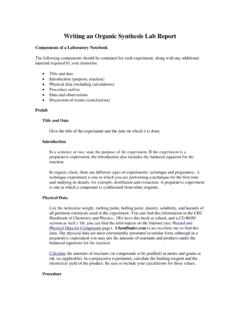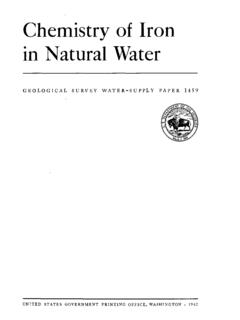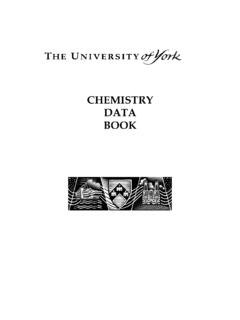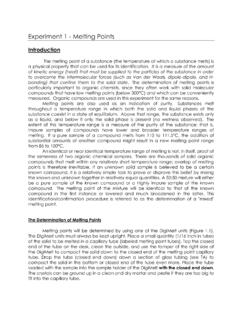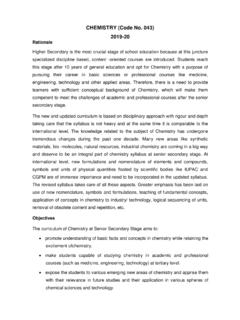Transcription of Mark scheme (A-level) : Paper 2 Organic and physical ...
1 A-LEVEL chemistry 7405/2 - Paper 2 Organic and physical chemistry Mark scheme June 2018 Version/Stage: Final MARK scheme A-LEVEL chemistry 7405/2 JUNE 2018 Copyright 2018 AQA and its licensors. All rights reserved. AQA retains the copyright on all its publications. However, registered schools/colleges for AQA are permitted to copy material from this booklet for their own internal use, with the following important exception: AQA cannot give permission to schools/colleges to photocopy any material that is acknowledged to a third party even for internal use within the centre.
2 Mark schemes are prepared by the Lead Assessment Writer and considered, together with the relevant questions, by a panel of subject teachers. This mark scheme includes any amendments made at the standardisation events which all associates participate in and is the scheme which was used by them in this examination. The standardisation process ensures that the mark scheme covers the students responses to questions and that every associate understands and applies it in the same correct way. As preparation for standardisation each associate analyses a number of students scripts.
3 Alternative answers not already covered by the mark scheme are discussed and legislated for. If, after the standardisation process, associates encounter unusual answers which have not been raised they are required to refer these to the Lead Assessment Writer. It must be stressed that a mark scheme is a working document, in many cases further developed and expanded on the basis of students reactions to a particular Paper . Assumptions about future mark schemes on the basis of one year s document should be avoided; whilst the guiding principles of assessment remain constant, details will change, depending on the content of a particular examination Paper .
4 Further copies of this mark scheme are available from MARK scheme A-LEVEL chemistry 7405/2 JUNE 2018 3 A-Level chemistry Mark scheme Instructions for Examiners 1. General The mark scheme for each question shows: the marks available for each part of the question the total marks available for the question the typical answer or answers which are expected extra information to help the examiner make his or her judgement and help to delineate what is acceptable or not worthy of credit or, in discursive answers, to give an overview of the area in which a mark or marks may be awarded.
5 The extra information in the Comments column is aligned to the appropriate answer in the left-hand part of the mark scheme and should only be applied to that item in the mark scheme . You should mark according to the contents of the mark scheme . If you are in any doubt about applying the mark scheme to a particular response, consult your Team Leader. At the beginning of a part of a question a reminder may be given, for example: where consequential marking needs to be considered in a calculation; or the answer may be on the diagram or at a different place on the script.
6 In general the right-hand side of the mark scheme is there to provide those extra details which might confuse the main part of the mark scheme yet may be helpful in ensuring that marking is straightforward and consistent. The use of M1, M2, M3 etc in the right-hand column refers to the marking points in the order in which they appear in the mark scheme . So, M1 refers to the first marking point, M2 the second marking point etc. 2. Emboldening In a list of acceptable answers where more than one mark is available any two from is used, with the number of marks emboldened.
7 Each of the following bullet points is a potential mark. A bold and is used to indicate that both parts of the answer are required to award the mark. Alternative answers acceptable for a mark are indicated by the use of OR. Different terms in the mark scheme are shown by a / ; eg allow smooth / free movement. 3. Marking points Marking of lists This applies to questions requiring a set number of responses, but for which students have provided extra responses. The general List principle to be followed in such a situation is that right + wrong = wrong.
8 MARK scheme A-LEVEL chemistry 7405/2 JUNE 2018 4 Each error / contradiction negates each correct response. So, if the number of error / contradictions equals or exceeds the number of marks available for the question, no marks can be awarded. However, responses considered to be neutral (often prefaced by Ignore in the mark scheme ) are not penalised. For example, in a question requiring 2 answers for 2 marks: Correct answers Incorrect answers ( incorrect rather than neutral) Mark (2) Comment 1 0 1 1 1 1 They have not exceeded the maximum number of responses so there is no penalty.
9 1 2 0 They have exceeded the maximum number of responses so the extra incorrect response cancels the correct one. 2 0 2 2 1 1 2 2 0 3 0 2 The maximum mark is 2 3 1 1 The incorrect response cancels out one of the two correct responses that gained credit. 3 2 0 Two incorrect responses cancel out the two marks gained. 3 3 0 Marking procedure for calculations Full marks should be awarded for a correct numerical answer, without any working shown, unless the question states Show your working or justify your answer . In this case, the mark scheme will clearly indicate what is required to gain full credit.
10 If an answer to a calculation is incorrect and working is shown, process mark(s) can usually be gained by correct substitution / working and this is shown in the Comments column or by each stage of a longer calculation. Errors carried forward, consequential marking and arithmetic errors Allowances for errors carried forward are most likely to be restricted to calculation questions and should be shown by the abbreviation ECF or consequential in the marking scheme . An arithmetic error should be penalised for one mark only unless otherwise amplified in the marking scheme .










